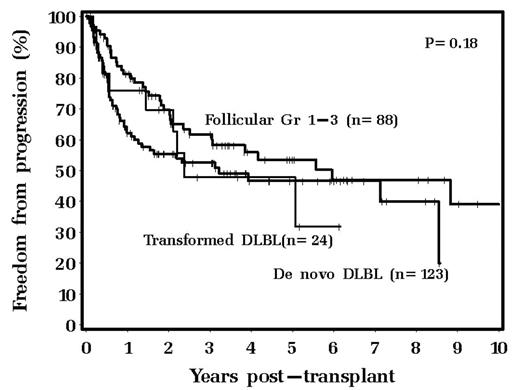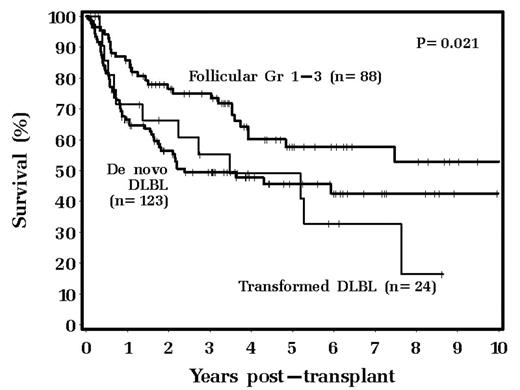Abstract
The decision to offer or not offer high dose therapy with ASCT to an individual lymphoma patient is sometimes (but perhaps mistakenly) based on the specific histology alone and not necessarily on patient characteristics, clinical manifestations, or disease behavior. Therefore, we reviewed the long-term outcome of FL, dnDLBL, and tDLBL patients, who received high dose chemotherapy (CT) with ASCT at the Cleveland Clinic, to determine if the specific histology is important. Between June 1991 and July 2004, 235 patients with FL, dnDLBL, or tDLBL in second or third remission received high dose CBV (n=7), BuCy (n=1), or BuCyVP (n=227) with ASCT. The median follow-up among survivors is 3.4 (.1–11.4) years.
Patient, disease, and ASCT characteristics and outcome according to histology
| Variable . | FL (n=88) . | dnDLBL (n=123) . | tDLBL (n=24) . | p-value . |
|---|---|---|---|---|
| Age: median (range) | 51(33–69) | 50(22–71) | 56(40–70) | 0.021 |
| Male sex: N (%) | 47(53) | 73(59) | 12(50) | 0.56 |
| Years from diagnosis to ASCT: median (range) | 2.6(0.4–17.5) | 1.5(0.3–15.6) | 3.4(1–14.0) | <0.001 |
| Prior #CT regimens: median (range) | 2(1–5) | 2(1–4) | 2(2–5) | <0.001 |
| Disease status at ASCT: CR2-PR2/CR3-PR3, N (%) | 61(69)/27(31) | 106(86)/17(14) | 16(67)/8(33) | 0.005 |
| Bone marrow involved at ASCT: N (%) | 16(21) | 12(10) | 1(4) | 0.035 |
| Prior radiation therapy: N (%) | 25(28) | 45(37) | 7(29) | 0.42 |
| LDH > normal at ASCT: N (%) | 60(69) | 65(54) | 12(50) | 0.06 |
| Tumor bulk >10 cm at ASCT: N (%) | 14(16) | 27(23) | 4(17) | 0.46 |
| Disease progression: N (%) | 35(40) | 55(45) | 10(42) | – |
| Death from lymphoma: N (%) | 21(24) | 42(34) | 7(29) | – |
| Death from any cause: N (%) | 31(35) | 58(47) | 13(54) | – |
| Variable . | FL (n=88) . | dnDLBL (n=123) . | tDLBL (n=24) . | p-value . |
|---|---|---|---|---|
| Age: median (range) | 51(33–69) | 50(22–71) | 56(40–70) | 0.021 |
| Male sex: N (%) | 47(53) | 73(59) | 12(50) | 0.56 |
| Years from diagnosis to ASCT: median (range) | 2.6(0.4–17.5) | 1.5(0.3–15.6) | 3.4(1–14.0) | <0.001 |
| Prior #CT regimens: median (range) | 2(1–5) | 2(1–4) | 2(2–5) | <0.001 |
| Disease status at ASCT: CR2-PR2/CR3-PR3, N (%) | 61(69)/27(31) | 106(86)/17(14) | 16(67)/8(33) | 0.005 |
| Bone marrow involved at ASCT: N (%) | 16(21) | 12(10) | 1(4) | 0.035 |
| Prior radiation therapy: N (%) | 25(28) | 45(37) | 7(29) | 0.42 |
| LDH > normal at ASCT: N (%) | 60(69) | 65(54) | 12(50) | 0.06 |
| Tumor bulk >10 cm at ASCT: N (%) | 14(16) | 27(23) | 4(17) | 0.46 |
| Disease progression: N (%) | 35(40) | 55(45) | 10(42) | – |
| Death from lymphoma: N (%) | 21(24) | 42(34) | 7(29) | – |
| Death from any cause: N (%) | 31(35) | 58(47) | 13(54) | – |
Kaplan-Meier freedom from progression curves accarding to histology are shown:
Kaplan-Meier overall survival curves according to histology are shown:
There is no significant difference in freedom from progression between FL, dnDLBL, and tDLBL patients transplanted in second or third remission. By Cox proportional univariate analysis, only male sex predicted a higher risk of progression while male sex, older age, and dnDLBL or tDLBL (compared to FL) predicted a higher risk of death. By Cox proportional multivariate analysis, no factor predicted a higher risk of progression while older age, male sex, and dnDLBL predicted a higher risk of death. In conclusion, high dose chemotherapy with ASCT leads to long-term remissions in 40–50% of FL, dnDLBL, and tDLBL patients in second or third remission. These results suggest that the distinction between these three histologies is less important than other factors in determining patient eligibility for ASCT.
Author notes
Corresponding author



This feature is available to Subscribers Only
Sign In or Create an Account Close Modal